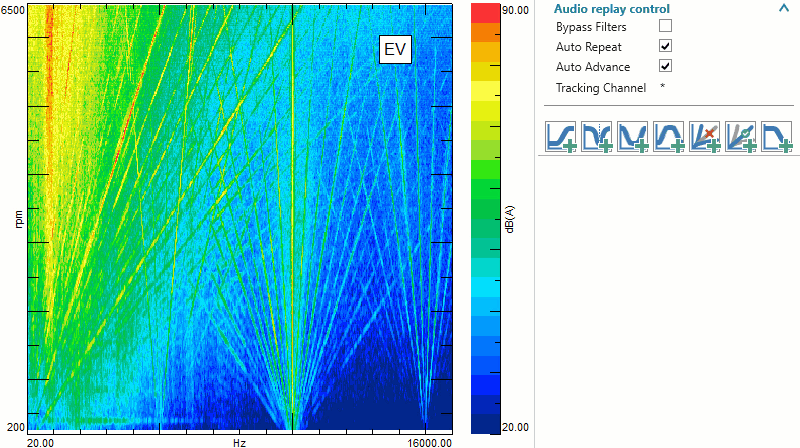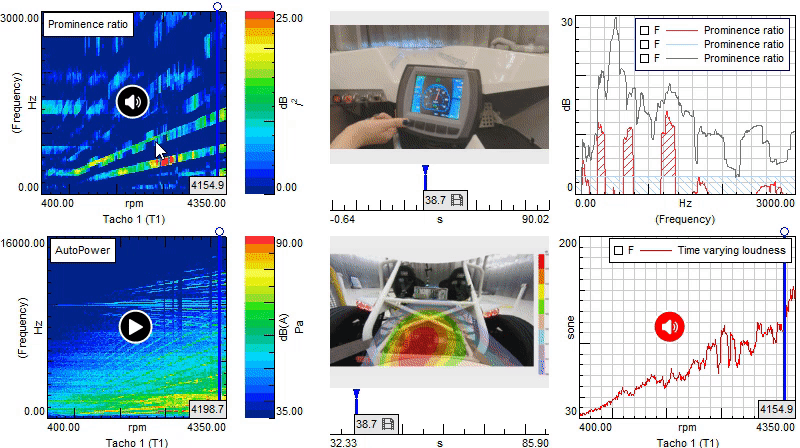Electric vehicles do not vroom

Few months ago, I came across this very entertaining Electric Vehicle commercial from Volkswagen Canada:
While I can appreciate Volkswagen for their creative approach to marketing, it made me realize that even though the commercial comes with a small-print warning:

It does fit into a certain trend of building the expectation that hybrid and electric vehicles are not only completely silent, but also pose no serious challenge to NVH engineers. Working in the automotive industry, we know that this is certainly not the case.
Goodbye orders, hello tones..?
The shift towards hybrid and electric vehicles is expected to have positive impact on the environment, but what about the driving comfort and sound quality? Bob Kruse, the CTO of Karma Automotive recently pointed out:
You do not have an internal combustion engine on all the time, making a lot of noise, that forgives a lot of other evils.
Bob Kruse, Chief Technology Officer of Karma Automotive
So, it’s safe to say that the NVH engineers won’t be out of job anytime soon, the noise is not gone, it has just shifted to other sources:

The real challenge however is the types of noises that have emerged with the shift. Turbocharger whine, inverter switching noise, engine powered accessories or the DC motors used to control your windows and seats all have one thing in common: their noise spectrum includes tonal components.
Sensitivity to tones
It is well known that humans on average are more sensitive to tones rather than broadband noise. Over the years, a vast number of research activities has been started to understand and quantify the annoyance caused by the presence of tonal noise in the environment. But why are the tones so much more noticeable? Since we already called them evil, let’s stay in that storyline.
Imagine that someone pricks your left hand with a needle (ouh!) and afterwards gently slaps your right hand. While the actual forces used in both cases can be very similar, your left hand will most likely make you feel more uncomfortable. Similar situation occurs in our auditory system. Tonal sound will result in a very localized excitation of a smaller amount of hair cells on the basilar membrane. Broadband noise will excite most cells across the complete membrane. So, to put it bluntly: someone would have to slap pretty hard, to create the same level of pain as the needle prick. If we take this metaphor further, the broadband noise can be compared to the famous Fakir’s bed, where the big amount of nails is the secret to not getting hurt while laying down.
Disclaimer: please do not try this at home!
Do not fear, Testlab is here!
With all of that in mind, the content of 2019.1.2 release has been carefully planned to make sure that Simcenter Testlab can support NVH and sound quality engineers (not only those working on EVs) even better, making them more productive and delivering more insight into the test results. Here are (in my personal, slightly biased opinion) 5 most important extensions to Testlab for sound quality:
Interactive audio filter sets
We have further enhanced the visualization of the filter cut-off frequencies during audio replay. It is now also possible to save and load complete sets of filters, also in real-time. Use the clearly marked buttons to add, remove, edit or disable the filters during replay to find the most problematic frequency content in the sound of your product.

More psychoacoustic metrics and off-zero order filtering
Sound Quality Analysis library has been expanded with more sound quality metrics:
- Fluctuation strength – to evaluate sounds with a slow amplitude modulation
- ECMA-74:2019 Tonality (Hearing Model) – to detect, rate and compare tonal issues in transient and stationary sounds
- ECMA-74:2019 Tone-to-noise ratio – to detect rate and compare tonal issues in stationary sounds
In the example below we’re comparing the start of the spinning cycle of two washing machines (it cannot be always about cars). You can see (and hear) how the different models score in terms of slow modulation value and the tonality of the sound:
Additionally, you can now calculate order sections on sound quality maps. Want more insight? Filter our off-zero orders and compare the results using the automatic preview and pivot view functionality.

Importing and synchronizing externally measured video files
Documenting your measurement with a GoPro camera recording can help in troubleshooting transient sound quality issues. You can now import and synchronize any externally measured MP4 video (from USB cameras, smartphones, tablets, etc.) .

In this example the electric vehicle under test has an option to enable the ECO mode. While in ECO mode, the vehicle uses regenerative braking. This causes a very tonal and unpleasant order 10.25 to become audible. We are using sound quality metrics to confirm that this order is the most prominent tonal component in the measured signal. The results shown a very strong correlation between the:
- enabled ECO mode (GoPro video)
- tonal 10.25th order (Prominence Ratio map)
- noise localization shifting to the Gearbox (Simcenter Sound Camera video)
You can especially hear and see it when at a certain moment the operator just turns the ECO mode off and on a few times in a row.

Fully calibrated and equalized audio replay
Audio replay in Simcenter Testlab Neo makes it very easy to not only calibrate your replay chain, but also to re-apply the head&torso correction on binaural measurements that have been equalized for analysis. Additionally, you can now remove the effect of headphones used during replay.

Replaying using HEAD’s acoustic playback systems? No worries; we’ve got you covered!
Subjective evaluate and rank sounds with Scheffé’s Method
Are you looking for an easy to conduct jury test, that will give you the same insight as category judgement or paired comparison? Simcenter Testlab Jury Testing has been extended with the Scheffé’s method of paired comparison.

..and many more!
Get your Simcenter Testlab 2019.1.2 upgrade today and let us know what you think! Follow this Knowledge base article on how to download and install Simcenter Testlab: https://community.sw.siemens.com/s/article/Simcenter-Testlab-Download-and-Installation-Instructions



Comments
Comments are closed.